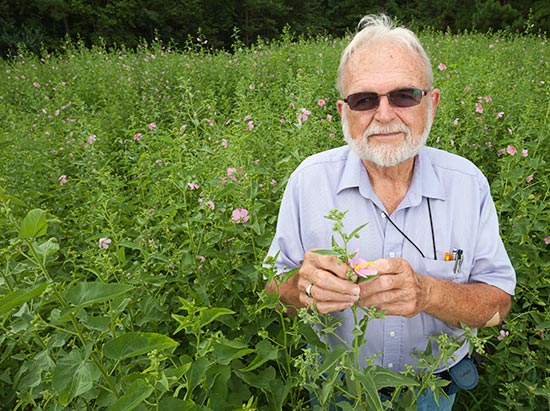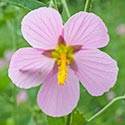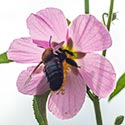



By Tracey Bryant Office of Communications and Marketing

Salt. It’s toxic to most plants. So as sea water washes onto farmland during coastal storms or turns irrigation water brackish, how will farmers fare? Traditional crops like corn and soybeans have little tolerance for salt water; they simply wither and die.
Jack Gallagher and Denise Seliskar, marine botanists in UD’s College of Earth, Ocean, and Environment, are experts on halophytes, plants that grow in wet, salty conditions. In the Halophyte Solutions Laboratory at the Hugh R. Sharp Campus in Lewes, and in nearby test plots outside, the researchers are working to develop seashore mallow, a native marsh plant known scientifically as Kosteletzkya pentacarpos, into a new salt-tolerant crop.
When it blooms in August and September, seashore mallow is easy to spot in Mid-Atlantic marshes — just look for the two-inch, pink, hibiscus-like flowers.
Yet seashore mallow is not only attractive, it also provides valuable products and services, the UD researchers have discovered, from biofuel and animal food to a vegetative buffer for land that otherwise would be left barren and eventually attract invasive plants.
“Seashore mallow produces seeds that are 18 percent oil by weight — oil that can be used to make biodiesel fuel,” Gallagher says. “Once the oil is extracted from the seeds, about 32 percent of what is left is protein that can be used in animal feed.”
The “straw” or stem of seashore mallow can be used as a feedstock for producing fiber products, such as oil-absorbent pellets, small mammal bedding, a hydroseeding medium for planting grass on road banks and even an organic kitty litter.
Seashore mallow offers a variety of other pluses to farmers facing the challenge of keeping bayside farmland productive in the face of sea level rise. As a perennial, seashore mallow is more sustainable than traditional oil seed crops because it does not need to be planted every year. And the plant’s substantial root system serves as a “carbon sink” in the soil, meaning it offsets the additions the oil releases into the atmosphere when used for fuel.
Gallagher points out other advantages: as a marsh plant, seashore mallow is naturally flood-tolerant, and its deep root system makes it drought tolerant. Also, traditional farm machinery can be used to plant and harvest it.
According to Gallagher, seashore mallow can be a big aid to coastal farms.
“Planting seashore mallow will enable farmland to remain agriculturally and economically viable for a longer period than if no such halophytic crop is planted while maintaining a nutrient-absorbing buffer between farmland and the marsh fringing the bay,” he says.
The UD team recently undertook a major reconnaissance mission along the Atlantic and Gulf coasts to find and collect seashore mallow for a selection and breeding program. Although easy to spot when in bloom, the plant is difficult to identify at other times because it’s not a dominant plant in most marshes.
To increase their chances of finding the plant, the researchers visited numerous herbaria, some with specimens reaching back to the 1800s, to learn where their seashore mallow had been collected. Then a volunteer, Dave Lewis, used Google Earth to locate the sites on a map. When the scientists got to the locations and actually found plants, they used GPS to pinpoint the specific collection sites.
They collected both whole plants and seeds, storing them in a plastic box cooled with ice, until they returned to the Lewes campus. There, biologist Donna Hamilton continues to care for the plants in the greenhouse. Offspring of these plants are now growing in field plots irrigated with fresh and salt water.
Even though Gallagher officially retired last year, the professor emeritus comes into the laboratory every day just as he always has, eager to continue the research. The team is now studying the seashore mallow specimens and making crosses among them to develop a superior plant line with all the characteristics desired for a salt-tolerant biofuel, feed and fiber crop.
Gallagher says, “I view seashore mallow as the ‘pig of the plant world’, having everything but the squeal useful.”
There’s often a correlation between the number of flower petals and the number of seeds a plant yields. Although Linnaeus gave seashore mallow its species name (pentacarpos) for five, the UD team has found specimens with six petals, which generally yield six seeds. This trait is actively being selected in UD plant breeding programs.


The bright pink, two-inch flowers of seashore mallow (Kosteletzkya pentacarpos) resemble those of a hibiscus. The blooms are a favorite of bees and hummingbirds.